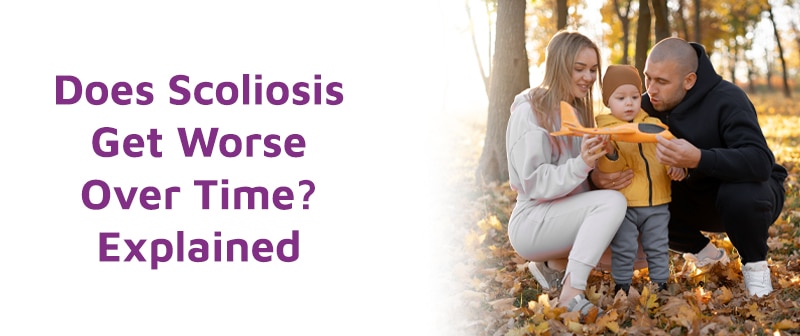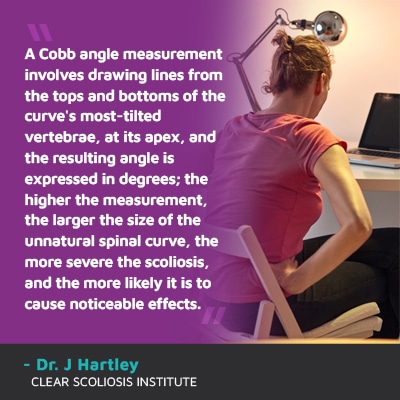
Scoliosis severity ranges widely from mild scoliosis to moderate scoliosis and severe cases. Scoliosis severity is largely determined by the size of the unnatural spinal curvature, but there are additional factors that shape the type of symptoms a patient will experience.
Scoliosis is a progressive condition, so its nature is to get worse over time, but it can be highly treatable, particularly with early detection and a proactive treatment approach. Most cases of scoliosis are idiopathic, but we know it's growth that makes it progress.
As a patient's journey with scoliosis starts with a diagnosis, let's discuss the process.
Scoliosis causes the spine to curve unnaturally to the side and rotate, and an unhealthy spinal curvature can affect the spine and entire body in a number of ways.
Scoliosis is diagnosed through a physical examination and X-ray results. Part of an assessment involves determining if there are risk factors in place.
While scoliosis isn't a genetic condition, it is familial, so a family history of scoliosis is considered an important risk factor that warrants regular screening to support early detection; in addition, as adolescent females are most often diagnosed, and as females also tend to progress more rapidly than males, a teenage female with a family history is the most at risk for developing scoliosis.
A patient's initial assessment needs to be comprehensive and accurate as treatment plans are shaped around the results, and an X-ray is needed to confirm the presence of rotation and take a number of measurements, the most important of which is a patient's Cobb angle measurement.

Scoliosis introduces uneven forces to the body that can increase over time.
Part of diagnosing scoliosis involves further classifying conditions based on a number of important variables because no two cases are the same, so let's talk about the progressive path of scoliosis.
As a progressive condition, the nature of scoliosis is to become worse over time, but it doesn't have to, with the help of a proactive treatment plan.
There are never treatment guarantees, but scoliosis can be highly treatable, particularly with early detection and intervention.
Scoliosis ranges widely from mild scoliosis to moderate scoliosis and severe scoliosis, and the more severe scoliosis becomes, or is at the time of diagnosis, the more challenging it can be to treat.
Scoliosis progression means the size and rotation of the unnatural spinal curve is increasing, as are condition effects.
With most scoliosis patients, the more severe their scoliosis is, the more noticeable it is.
Mild scoliosis is diagnosed with a Cobb angle of between 10 and 25 degrees, and this is the best time to start treatment because the curve is small, flexible, and condition effects aren't yet well established.
Most cases of scoliosis are idiopathic, so we don't know what causes their initial development, but we know it's growth that makes it progress.
Rapid curve progression is most closely associated with childhood scoliosis, and adolescent idiopathic scoliosis is the most prevalent type overall, commonly diagnosed at the onset of puberty.
Due to the rapid and unpredictable growth spurts of puberty, how scoliosis is managed during growth is key; even scoliosis diagnosed as mild can quickly progress and become moderate and/or severe scoliosis.
The term mild doesn't mean the scoliosis will stay that way without the help of proactive treatment; being diagnosed with mild scoliosis means early detection has been achieved and the potential benefits of early intervention may be within reach.
The best way to manage scoliosis and counteract its progressive nature is to be proactive with treatment, particularly during periods of growth.
Adults are also affected by scoliosis; the two main types of adult scoliosis are idiopathic scoliosis and degenerative scoliosis.
Cases of degenerative scoliosis affect older adults and involve spinal degeneration causing instability, so these cases are almost always progressive, and fall prevention is a focus of treatment.
Treating scoliosis successfully means counteracting its progressive nature during growth, restoring the spine's alignment, improving posture, and the balance/strength of the spine's surrounding muscles.
Restoring the spine's alignment means restoring as much of the spine's healthy curves as possible, and a curvature reduction can improve the spine's balance and stability.
As spinal health is key to overall health and body positioning, addressing scoliosis can have a number of benefits felt throughout the body.

Treating scoliosis successfully means improving spinal health for improvements to a patient's overall health; the ability to stand upright, practice healthy posture, and healthy movement patterns are shaped by a person's spinal health.
Conservative treatment is integrative and combines the potential of multiple scoliosis-specific types of treatment.
From chiropractic adjustments to physical therapy and corrective bracing, improvements to the spine's alignment is a priority as it shapes the spine's overall balance and stability.
Chiropractic care can work towards improving the spine's structural position, and physical therapy focuses on postural improvement, along with improving the balance and strength of the back and core muscles: improving spinal stability through increasing spinal support.
Teaching postural awareness so patients know how to hold their bodies during daily activity is an important facet of sustaining treatment results; patients are taught specific corrective exercises they can continue performing from home.
Treating childhood scoliosis successfully means managing it effectively during periods of rapid growth, and as growing spines are more malleable, corrective bracing is at the center of childhood scoliosis treatment plans.
When it comes to addressing adult scoliosis, the treatment focus is often on pain management and improving spinal stability for fall prevention.
Here at the CLEAR Scoliosis Institute, securing the best possible treatment outcome for the patient is the ultimate focus of treatment, and as a CLEAR-certified scoliosis chiropractor, this involves a combination of proven nonsurgical disciplines.
While the nature of scoliosis is to get worse over time, it doesn't have to; scoliosis can be highly treatable and responsive, and while early detection and intervention doesn't guarantee treatment success, it does increase its likelihood.
An early scoliosis diagnosis can be reached through awareness; knowing the condition's early signs to watch for, particularly in children, can lead to early detection and starting treatment while scoliosis is mild and most likely to respond well.
In children, the earliest signs involve postural changes like uneven shoulders and hips, and changes to movement are also common; in adults, it's back and radiating pain into the extremities that leads to most diagnoses.
As scoliosis progression is triggered by growth, a patient's severity level can change quickly, and the longer scoliosis is left untreated, the more likely it is to continue progressing and lead to related complications and/or a recommendation for scoliosis surgery.
So does scoliosis get worse over time? As a progressive condition, most cases will increase in severity over time, particularly in young patients who are still growing.

CLEAR provides a unique and innovative way of understanding scoliosis. Sign up to receive facts and information you won’t find anywhere else.
